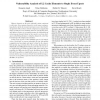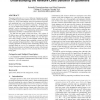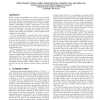1511 search results - page 81 / 303 » On the effectiveness of address-space randomization |
ICCSA
2007
Springer
14 years 2 months ago
2007
Springer
Abstract. In this work, we develop novel file system, FRASH, for byteaddressable NVRAM (FRAM[1]) and NAND Flash device. Byte addressable NVRAM and NAND Flash is typified by the DRA...
DATE
2006
IEEE
14 years 1 months ago
2006
IEEE
Memory elements are the most vulnerable system component to soft errors. Since memory elements in cache arrays consume a large fraction of the die in modern microprocessors, the p...
SIGCOMM
2006
ACM
14 years 1 months ago
2006
ACM
This paper studies the network-level behavior of spammers, including: IP address ranges that send the most spam, common spamming modes (e.g., BGP route hijacking, bots), how persi...
PADS
2005
ACM
14 years 1 months ago
2005
ACM
Most well-known Internet worms, such as Code Red, Slammer, and Blaster, infected vulnerable computers by scanning the entire Internet IPv4 space. In this paper, we present a new s...
ACSAC
2004
IEEE
13 years 11 months ago
2004
IEEE
Buffer overflow vulnerabilities are caused by programming errors that allow an attacker to cause the program to write beyond the bounds of an allocated memory block to corrupt oth...



